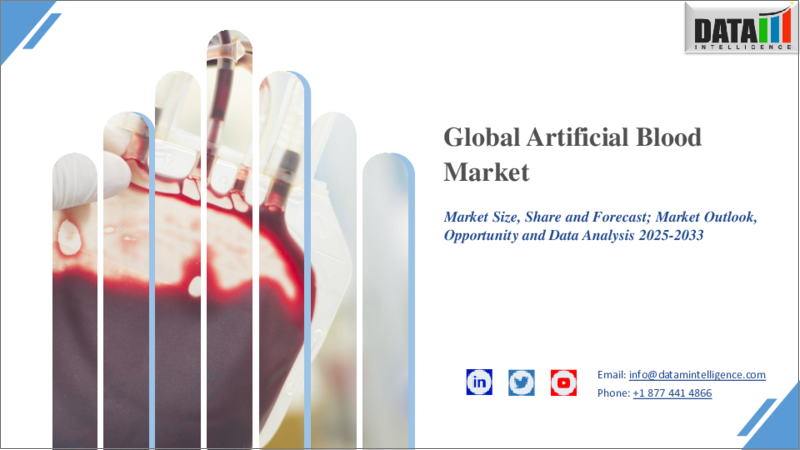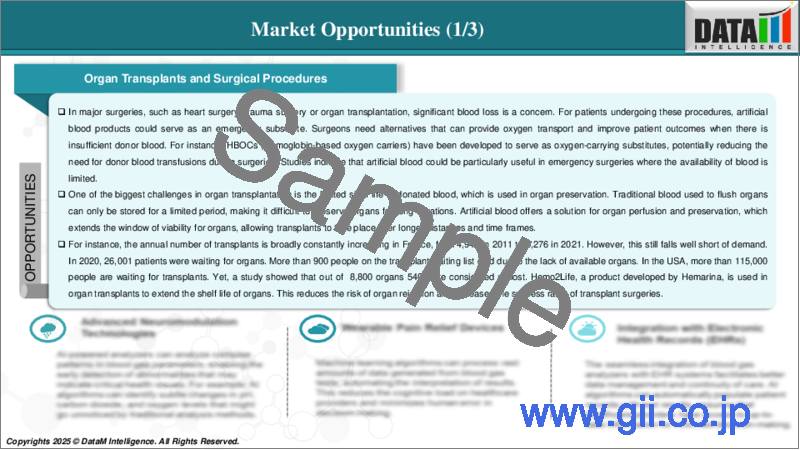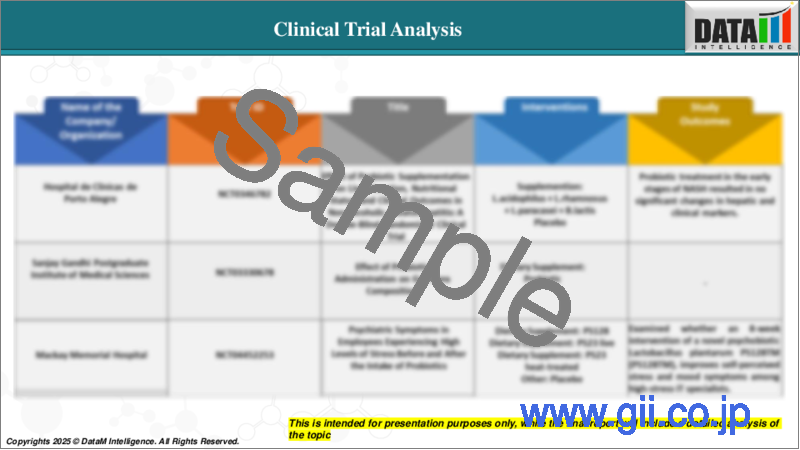|
|
市場調査レポート
商品コード
1542870
人工血液の世界市場:2024~2031年Global Artificial Blood Market - 2024-2031 |
||||||
カスタマイズ可能
適宜更新あり
|
|||||||
| 人工血液の世界市場:2024~2031年 |
|
出版日: 2024年08月26日
発行: DataM Intelligence
ページ情報: 英文 176 Pages
納期: 即日から翌営業日
|
- 全表示
- 概要
- 目次
世界の人工血液の市場規模は、2023年に37億6,000万米ドルに達し、2024~2031年にかけてCAGR 8.7%で成長し、2031年には71億9,483万米ドルに達すると予測されています。
真の血液がさまざまな機能を果たすのに対し、人工血液は体内で酸素と二酸化炭素を運搬するように設計されています。人工血液は、そのタイプに応じて、合成生産、化学的分離、組み換え生化学技術など、さまざまな方法で製造することができます。
人工血液の利点には、酸素運搬能力の向上、外傷や戦場での時間の節約、通常の血液よりも高い生命力、病気が広がる可能性の低さ、より大量の血液を製造できることなど、同種輸血よりも重要な利点があります。人工血液は、ヘモグロビン系酸素運搬体やパーフルオロカーボンエマルジョンとして市場に出回っています。
市場力学:
促進要因と抑制要因
研究開発の活発化
研究開発の進展が市場の成長を牽引するとみられます。現在進行中の研究は、免疫学的反応や毒性といった人工血液の安全性問題への対処に重点を置いています。研究開発の進展は、副作用の少ないより安全な人工血液の開発につながり、医師や患者による人工血液の使用への受け入れを増加させる。研究者は、副作用の少ない血液を模倣できる製品の開発に注力しています。
例えば、2022年11月、NIHRが資金を提供し支援する世界初の臨床試験が、実験室で培養した赤血球を人々に投与することを開始しました。RESTORE臨床試験(REcovery and survival of STem cell Originated REd cells)は、赤血球製品のNIHR血液・移植研究ユニットによって開始されました。
さらに、Bioxytran, Inc.は2024年7月18日、輸血に代わる万能酸素運搬体(UOC)を開発するためのヘム財団との合弁事業を発表しました。
また、Nara Medical Universityは2024年7月27日、緊急時の輸血用に保存可能な人工赤血球の臨床研究を2025年3月までに日本で開始すると発表しました。
人工血液の副作用
ヘモグロビンを用いた酸素キャリアの副作用には、高血圧、腹痛、皮疹、下痢、黄疸、ヘモグロビン尿、乏尿、発熱、脳卒中、リパーゼの増加などの検査値異常などがあります。これらの副作用は、外科手術や輸血における人工血液の採用を減らす可能性があります。
市場セグメンテーション
世界の人工血液市場は、製品タイプ、供給源、プロセス、用途、エンドユーザー、地域によって区分されます。
ヘモグロビン系酸素運搬体分野が市場シェアを独占する見込みです。
ヘモグロビン系酸素運搬体分野は、様々な要因から市場シェアで大きな位置を占めると予想されます。HBOCは、赤血球中の天然ヘモグロビンの機能に匹敵する酸素を効率的に輸送・放出するように開発されています。このため、特に緊急時の酸素供給には極めて有効です。
HBOCは、手術、怪我、貧血治療など、さまざまな医療現場で採用することができます。HBOCの適応能力は、数多くの用途における商業的可能性を高めています。HBOCの有効性と安全性を向上させるために多額の研究開発投資が行われており、その結果、臨床現場での採用が増加する可能性があります。したがって、上記の要因が市場シェアにおいて重要な位置を占めると予想されます。
市場地域別シェア
北米が人工血液市場シェアで重要な位置を占めると予想される
北米は、予測期間中、世界の人工血液市場を独占しています。これは、入院前の過剰出血による外傷死の増加、貧血および血液関連疾患の地域全体での有病率の増加が、新規人工血液の開発につながったためです。
同地域では、元の人間の血液を代替し、貧血患者やその他の患者の輸血プロセスに使用するための人工血液の開発研究が高まっており、同地域の市場成長を促進すると予想されています。
例えば、UMSOMの発表によると、UMSOMは、メリーランド大学薬学部(UMSOP)および10以上の大学やバイオテクノロジー会社と共同で、国防高等研究計画局(DARPA)が管理する4,640万米ドルの4年間の研究プロジェクトを管理します。メリーランド大学薬学部の医師科学者が、連邦政府資金による新しい研究プログラムの責任者となり、室温で保存可能な全血製剤を開発・試験し、負傷から30分以内に現場で負傷兵に輸血できるようにすることで、数千人の命を救う可能性があります。
目次
第1章 調査手法と調査範囲
第2章 定義と概要
第3章 エグゼクティブサマリー
第4章 市場力学
- 影響要因
- 促進要因
- 研究開発の進歩の高まり
- 抑制要因
- 人工血液の悪影響
- 機会
- 影響分析
- 促進要因
第5章 産業分析
- ポーターのファイブフォース分析
- サプライチェーン分析
- 価格分析
- 規制分析
- 償還分析
- 特許分析
- SWOT分析
- DMIオピニオン
第6章 製品タイプ別
- ヘモグロビン系酸素運搬体
- パーフルオロカーボンエマルジョン
第7章 供給源別
- ヒトヘモグロビン
- 動物ヘモグロビン
- 幹細胞
- 合成ポリマー
- 微生物
- その他
第8章 プロセス別
- 合成生産
- 化学単離
- 組み換え生化学技術
第9章 用途別
- 貧血
- 臓器移植
- 傷害・外傷
- 心血管疾患
- 母体疾患
- その他
第10章 エンドユーザー別
- 病院
- クリニック
- 血液バンク
- 研究機関
- その他
第11章 地域別
- 北米
- 米国
- カナダ
- メキシコ
- 欧州
- ドイツ
- 英国
- フランス
- イタリア
- スペイン
- その他の欧州
- 南米
- ブラジル
- アルゼンチン
- その他の南米
- アジア太平洋
- 中国
- インド
- 日本
- 韓国
- その他のアジア太平洋
- 中東・アフリカ
第12章 競合情勢
- 競合シナリオ
- 市況/シェア分析
- 合併・買収分析
第13章 企業プロファイル
- Hemarina
- KaloCyte, Inc.
- SpheriTech Limited
- Hemoglobin Oxygen Therapeutics LLC.
第14章 付録
Overview
Global Artificial Blood Market reached US$ 3760.00 million in 2023 and is expected to reach US$ 7194.83 million by 2031, growing at a CAGR of 8.7% during the forecast period 2024-2031.
While true blood performs different functions, artificial blood is designed to transport oxygen and carbon dioxide through the body. Based on the type of artificial blood it can be produced in different ways including synthetic production, chemical isolation, or recombinant biochemical technology.
The advantages of artificial blood include providing critical benefits over allogenic blood transfusions by delivering increased oxygen-carrying capacity, saving time in trauma cases and battlefield scenarios, higher life than regular blood, minor chances of the disease spreading, and the ability to manufacture larger quantities of blood. Artificial blood is available in the market in terms of hemoglobin-based oxygen carriers and perfluorocarbon emulsions.
Market Dynamics: Drivers & Restraints
Rising advancements in research and development
The rising research and development are expected to drive the market growth. Ongoing research is focused on addressing safety issues of artificial blood, such as immunological reactions and toxicity. Advancements in R&D can result in safer blood replacements with fewer adverse effects, increasing physician and patient acceptance of their use. Researchers are focusing on the development of products that could mimic the blood with fewer side effects.
For instance, in November 2022, a world-first clinical trial funded and supported by NIHR started giving lab-grown red blood cells to people. The RESTORE clinical trial (REcovery and survival of STem cell Originated REd cells) was initiated by the NIHR Blood and Transplant Research Unit in Red Blood Cell Products.
Additionally, on July 18, 2024, Bioxytran, Inc. announced a Joint Venture with the Heme Foundation to develop a Universal Oxygen Carrier ("UOC") as an alternative to blood transfusions.
And, on July 27, 2024, Nara Medical University stated that it will begin a clinical study of artificial red blood cells that can be stored for transfusions in times of emergency in Japan by next March 2025.
Adverse effects of artificial blood
Adverse effects of hemoglobin-based oxygen carriers include hypertension, abdominal pain, skin rash, diarrhea, jaundice, hemoglobinuria, oliguria, fever, stroke, and laboratory abnormalities such as an increase in lipase. These adverse reactions could reduce the adoption of artificial blood in surgical procedures and for transfusions.
Market Segment Analysis
The global artificial blood market is segmented based on product type, source, process, application, end-user, and region.
Hemoglobin-based oxygen carriers segment is expected to dominate the market share
Hemoglobin-based oxygen carriers segment is expected to hold a significant position in the market share due to a variety of factors. HBOCs have been developed to efficiently transport and release oxygen, which is comparable to the function of natural hemoglobin in red blood cells. This makes them extremely effective for oxygen delivery, especially in situations of emergency.
HBOCs can be employed in a variety of medical settings, including operations, injuries, and anemia therapies. Their ability to adapt improves their commercial potential across numerous applications. Significant R&D investment is being made to improve the efficacy and safety features of HBOCs, resulting in advances that can increase their adoption in clinical settings. Thus, the above factors are expected to hold a significant position in the market share.
Market Geographical Share
North America is expected to hold a significant position in the artificial blood market share
North America dominates the global artificial blood market during the forecast period owing to the rise in trauma deaths due to excessive blood loss before admission, and an increase in the prevalence of anemia and blood-related disorders across the region leading to the development of novel artificial blood.
The rising studies in the development of artificial blood in the region to substitute the original human blood and use it for the transfusion processes in the anemic and other patients are expected to drive market growth in the region.
For instance, according to a publication by UMSOM, UMSOM will manage the $46.4 million four-year research project administered by the Defense Advanced Research Projects Agency (DARPA), in collaboration with the University of Maryland School of Pharmacy (UMSOP) and more than a dozen universities and biotech companies. A Physician-scientist of UMSOM will head the new federally-funded research program to develop and test a whole blood product, storable at room temperature, that can be used to transfuse wounded soldiers in the field within 30 minutes of injury, potentially saving thousands of lives
Market Segmentation
By Product Type
Hemoglobin-based Oxygen Carriers
Perfluorocarbon Emulsion
By Source
Human Hemoglobin
Animal Hemoglobin
Stem Cells
Synthetic Polymers
Microorganisms
Others
By Process
Synthetic Production
Chemical Isolation
Recombinant Biochemical Technology
By Application
Anemia
Organ Transplantation
Injuries & Trauma
Cardiovascular Diseases
Maternal Conditions
Others
By End-User
Hospitals
Clinics
Blood Banks
Research Institutes
Others
By Region
North America
The U.S.
Canada
Mexico
Europe
Germany
UK
France
Italy
Spain
Rest of Europe
South America
Brazil
Argentina
Rest of South America
Asia-Pacific
China
India
Japan
South Korea
Rest of Asia-Pacific
Middle East and Africa
Market Competitive Landscape
The major global players in the market include Hemarina, KaloCyte, Inc., SpheriTech Limited, and Hemoglobin Oxygen Therapeutics LLC among others.
Why Purchase the Report?
To visualize the global artificial blood market segmentation based on product type, source, process, application, end-user, and region as well as understand key commercial assets and players.
Identify commercial opportunities by analyzing trends and co-development.
Excel data sheet with numerous data points of artificial blood market-level with all segments.
PDF report consists of a comprehensive analysis after exhaustive qualitative interviews and an in-depth study.
Product mapping available as Excel consisting of key products of all the major players.
The global artificial blood market report would provide approximately 53 tables, 47 figures, and 176 pages.
Target Audience 2024
Manufacturers/ Buyers
Industry Investors/Investment Bankers
Research Professionals
Emerging Companies
Table of Contents
1. Methodology and Scope
- 1.1. Research Methodology
- 1.2. Research Objective and Scope of the Report
2. Definition and Overview
3. Executive Summary
- 3.1. Snippet by Product Type
- 3.2. Snippet by Source
- 3.3. Snippet by Process
- 3.4. Snippet by Application
- 3.5. Snippet by End-User
- 3.6. Snippet by Region
4. Dynamics
- 4.1. Impacting Factors
- 4.1.1. Drivers
- 4.1.1.1. Rising advancements in research and development
- 4.1.2. Restraints
- 4.1.2.1. Adverse effects of artificial blood
- 4.1.3. Opportunity
- 4.1.4. Impact Analysis
- 4.1.1. Drivers
5. Industry Analysis
- 5.1. Porter's Five Force Analysis
- 5.2. Supply Chain Analysis
- 5.3. Pricing Analysis
- 5.4. Regulatory Analysis
- 5.5. Reimbursement Analysis
- 5.6. Patent Analysis
- 5.7. SWOT Analysis
- 5.8. DMI Opinion
6. By Product Type
- 6.1. Introduction
- 6.1.1. Market Size Analysis and Y-o-Y Growth Analysis (%), By Product Type
- 6.1.2. Market Attractiveness Index, By Product Type
- 6.2. Hemoglobin-based Oxygen Carriers*
- 6.2.1. Introduction
- 6.2.2. Market Size Analysis and Y-o-Y Growth Analysis (%)
- 6.3. Perfluorocarbon Emulsion
7. By Source
- 7.1. Introduction
- 7.1.1. Market Size Analysis and Y-o-Y Growth Analysis (%), By Source
- 7.1.2. Market Attractiveness Index, By Source
- 7.2. Human Hemoglobin*
- 7.2.1. Introduction
- 7.2.2. Market Size Analysis and Y-o-Y Growth Analysis (%)
- 7.3. Animal Hemoglobin
- 7.4. Stem Cells
- 7.5. Synthetic Polymers
- 7.6. Microorganisms
- 7.7. Others
8. By Process
- 8.1. Introduction
- 8.1.1. Market Size Analysis and Y-o-Y Growth Analysis (%), By Process
- 8.1.2. Market Attractiveness Index, By Process
- 8.2. Synthetic Production*
- 8.2.1. Introduction
- 8.2.2. Market Size Analysis and Y-o-Y Growth Analysis (%)
- 8.3. Chemical Isolation
- 8.4. Recombinant Biochemical Technology
9. By Application
- 9.1. Introduction
- 9.1.1. Market Size Analysis and Y-o-Y Growth Analysis (%), By Application
- 9.1.2. Market Attractiveness Index, By Application
- 9.2. Anemia*
- 9.2.1. Introduction
- 9.2.2. Market Size Analysis and Y-o-Y Growth Analysis (%)
- 9.3. Organ Transplantation
- 9.4. Injuries & Trauma
- 9.5. Cardiovascular Diseases
- 9.6. Maternal Conditions
- 9.7. Others
10. By End-User
- 10.1. Introduction
- 10.1.1. Market Size Analysis and Y-o-Y Growth Analysis (%), By End-User
- 10.1.2. Market Attractiveness Index, By End-User
- 10.2. Hospitals*
- 10.2.1. Introduction
- 10.2.2. Market Size Analysis and Y-o-Y Growth Analysis (%)
- 10.3. Clinics
- 10.4. Blood Banks
- 10.5. Research Institutes
- 10.6. Others
11. By Region
- 11.1. Introduction
- 11.1.1. Market Size Analysis and Y-o-Y Growth Analysis (%), By Region
- 11.1.2. Market Attractiveness Index, By Region
- 11.2. North America
- 11.2.1. Introduction
- 11.2.2. Key Region-Specific Dynamics
- 11.2.2.1. Market Size Analysis and Y-o-Y Growth Analysis (%), By Product Type
- 11.2.2.2. Market Size Analysis and Y-o-Y Growth Analysis (%), By Source
- 11.2.2.3. Market Size Analysis and Y-o-Y Growth Analysis (%), By Process
- 11.2.2.4. Market Size Analysis and Y-o-Y Growth Analysis (%), By Application
- 11.2.2.5. Market Size Analysis and Y-o-Y Growth Analysis (%), By End-User
- 11.2.3. Market Size Analysis and Y-o-Y Growth Analysis (%), By Country
- 11.2.3.1. The U.S.
- 11.2.3.2. Canada
- 11.2.3.3. Mexico
- 11.3. Europe
- 11.3.1. Introduction
- 11.3.2. Key Region-Specific Dynamics
- 11.3.2.1. Market Size Analysis and Y-o-Y Growth Analysis (%), By Product Type
- 11.3.2.2. Market Size Analysis and Y-o-Y Growth Analysis (%), By Source
- 11.3.2.3. Market Size Analysis and Y-o-Y Growth Analysis (%), By Process
- 11.3.2.4. Market Size Analysis and Y-o-Y Growth Analysis (%), By Application
- 11.3.3. Market Size Analysis and Y-o-Y Growth Analysis (%), By End-User
- 11.3.4. Market Size Analysis and Y-o-Y Growth Analysis (%), By Country
- 11.3.4.1. Germany
- 11.3.4.2. UK
- 11.3.4.3. France
- 11.3.4.4. Italy
- 11.3.4.5. Spain
- 11.3.4.6. Rest of Europe
- 11.4. South America
- 11.4.1. Introduction
- 11.4.2. Key Region-Specific Dynamics
- 11.4.2.1. Market Size Analysis and Y-o-Y Growth Analysis (%), By Product Type
- 11.4.2.2. Market Size Analysis and Y-o-Y Growth Analysis (%), By Source
- 11.4.2.3. Market Size Analysis and Y-o-Y Growth Analysis (%), By Process
- 11.4.2.4. Market Size Analysis and Y-o-Y Growth Analysis (%), By Application
- 11.4.3. Market Size Analysis and Y-o-Y Growth Analysis (%), By End-User
- 11.4.4. Market Size Analysis and Y-o-Y Growth Analysis (%), By Country
- 11.4.4.1. Brazil
- 11.4.4.2. Argentina
- 11.4.4.3. Rest of South America
- 11.5. Asia-Pacific
- 11.5.1. Introduction
- 11.5.2. Key Region-Specific Dynamics
- 11.5.2.1. Market Size Analysis and Y-o-Y Growth Analysis (%), By Product Type
- 11.5.2.2. Market Size Analysis and Y-o-Y Growth Analysis (%), By Source
- 11.5.2.3. Market Size Analysis and Y-o-Y Growth Analysis (%), By Process
- 11.5.2.4. Market Size Analysis and Y-o-Y Growth Analysis (%), By Application
- 11.5.3. Market Size Analysis and Y-o-Y Growth Analysis (%), By End-User
- 11.5.4. Market Size Analysis and Y-o-Y Growth Analysis (%), By Country
- 11.5.4.1. China
- 11.5.4.2. India
- 11.5.4.3. Japan
- 11.5.4.4. South Korea
- 11.5.4.5. Rest of Asia-Pacific
- 11.6. Middle East and Africa
- 11.6.1. Introduction
- 11.6.2. Key Region-Specific Dynamics
- 11.6.2.1. Market Size Analysis and Y-o-Y Growth Analysis (%), By Product Type
- 11.6.2.2. Market Size Analysis and Y-o-Y Growth Analysis (%), By Source
- 11.6.2.3. Market Size Analysis and Y-o-Y Growth Analysis (%), By Process
- 11.6.2.4. Market Size Analysis and Y-o-Y Growth Analysis (%), By Application
- 11.7. Market Size Analysis and Y-o-Y Growth Analysis (%), By End-User
12. Competitive Landscape
- 12.1. Competitive Scenario
- 12.2. Market Positioning/Share Analysis
- 12.3. Mergers and Acquisitions Analysis
13. Company Profiles
- 13.1. Hemarina *
- 13.1.1. Company Overview
- 13.1.2. Product Portfolio and Description
- 13.1.3. Financial Overview
- 13.1.4. Key Developments
- 13.2. KaloCyte, Inc.
- 13.3. SpheriTech Limited
- 13.4. Hemoglobin Oxygen Therapeutics LLC. (*LIST NOT EXHAUSTIVE)
14. Appendix
- 14.1. About Us and Services
- 14.2. Contact Us






